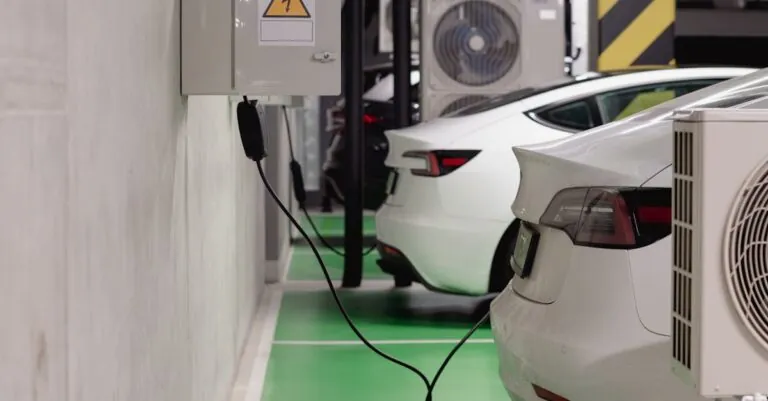As winter rolls in and snow blankets the roads, many drivers ponder a pressing question: can electric cars handle the frosty terrain? While visions of sleek EVs gliding effortlessly through snowflakes might seem like a scene from a sci-fi movie, the reality is a bit more grounded—and surprisingly promising.
Table of Contents
ToggleOverview Of Electric Cars In Winter Conditions
Electric cars perform well in winter conditions, including snowy environments. Understanding their capabilities in such situations is essential for potential owners.
Importance Of Understanding Performance
Recognizing electric cars’ performance in snow affects consumer decisions. Buyers seek confidence in their vehicle’s traction and handling. Evaluating how battery life and weight distribution influence stability becomes crucial. Knowing that many EVs feature advanced traction control systems helps vehicle owners. Owners should also understand the technology that aids in maintaining optimal grip on icy roads.
Factors Affecting Performance In Snow
Several factors impact electric vehicles’ performance in snowy conditions. Tire choice significantly affects traction. Winter tires generally outperform all-season tires on snow and ice. Battery temperature plays a key role as well; cold weather can reduce efficiency. Vehicle design, including weight distribution and center of gravity, influences stability on slippery surfaces. Lastly, regenerative braking technology can assist in maintaining control while driving.
Battery Performance In Cold Weather
Battery performance significantly decreases in cold weather, affecting electric vehicles’ (EVs) range and efficiency. Cold temperatures lead to increased resistance within the battery, causing shorter driving distances.
Impact Of Cold Temperatures
Cold weather can reduce battery capacity by up to 40 percent. This decrease impacts how far an electric car can travel in snowy conditions. Charging times also extend, with colder temperatures slowing down the chemical reactions within the battery. Drivers may notice a drop in performance during acceleration as well, due to less available power. Despite these challenges, many electric cars are designed to operate effectively in winter settings, equipped with thermal management systems to preserve battery function.
How To Optimize Battery Life
To optimize battery life in cold weather, several strategies help maintain performance. Parking indoors can protect the vehicle from extreme temperatures. Additionally, preconditioning the battery while plugged in allows it to reach an ideal operating temperature before driving. Utilizing seat heaters instead of cabin heat reduces the energy load on the battery. Monitoring tire pressure regularly ensures optimal contact with the road, vital for maintaining traction in snow. Following these practices improves battery performance during winter months.
Electric Drive Systems And Traction
Electric vehicles navigate snowy terrains effectively thanks to their drive systems. Understanding the difference between all-wheel drive and two-wheel drive enhances insights into their traction capabilities.
All-Wheel Drive Vs. Two-Wheel Drive
All-wheel drive (AWD) enhances traction on slippery surfaces. This system distributes power to all wheels, providing better grip in snow. Many electric cars equipped with AWD demonstrate superior handling in winter conditions. Two-wheel drive (2WD), while more energy-efficient, can struggle in deep snow. These vehicles primarily send power to either the front or rear wheels, which may result in reduced stability on icy roads. Ev owners often benefit from selecting a model with AWD for optimal performance in inclement weather.
Benefits Of Regenerative Braking
Regenerative braking offers significant advantages in snowy conditions. This technology transforms kinetic energy into electricity during braking, enhancing efficiency. In winter driving, it reduces reliance on traditional brakes; thus, minimizing wheel slip on icy roads. EVs utilizing regenerative braking maintain better tire traction, allowing for smoother deceleration. Drivers can appreciate the added safety and control winter conditions demand. Enhanced battery life represents a further bonus as energy recaptured helps extend driving range in adverse weather. By leveraging regenerative braking, electric cars provide drivers with an efficient and safer experience in snow.
Real-World Experiences And Reviews
Consumers report a variety of experiences with electric cars in snowy conditions. Many drivers appreciate the smooth handling and quick torque provided by electric motors. Drivers frequently note that all-wheel drive models, like the Tesla Model Y, perform admirably in snow, delivering enhanced stability and confidence.
User Testimonials
Owners often share positive stories of navigating winter weather with their electric cars. One user mentioned feeling secure on icy roads, stating that their electric vehicle’s traction control was effective. Another driver emphasized the efficiency of using seat heaters, which helped maintain battery levels during long trips in freezing temperatures. They also highlighted that the vehicle’s thermal management system kept the battery functional even in harsh conditions.
Performance Comparisons With Gas Vehicles
Comparing electric vehicles to gas-powered ones reveals notable differences in winter performance. Electric cars typically outperform their gas counterparts in handling snowy terrains due to instant torque delivery and superior traction systems. Owners of gas vehicles often struggle with stability in deep snow, while EV drivers enjoy features like regenerative braking, which provides a smoother ride and better grip. Additionally, electric models often feature advanced all-wheel drive systems that enhance control on slippery surfaces, reinforcing their capabilities in challenging climates.
Recommendations For Driving Electric Cars In Snow
Driving electric cars in snow requires attention to safety and the right equipment. Adapting to winter conditions enhances performance and ensures a smooth experience.
Essential Safety Tips
Maintain awareness of road conditions to mitigate risks. Utilize winter tires to improve grip on icy surfaces; these tires provide better traction than all-season varieties. Keep the battery charged to maximize range, especially in cold temperatures. Monitor tire pressure regularly, as colder weather often reduces tire air pressure, which impacts handling. Adjust driving habits by accelerating gently and braking slowly to prevent slips. Familiarize yourself with the vehicle’s traction control features; many electric cars come equipped with systems that enhance stability on slippery roads.
Equipment And Accessories To Consider
Investing in the right accessories can enhance the winter driving experience. Snow chains improve traction in deep snow, providing added grip when needed. A windshield cover facilitates ice removal, saving time and reducing visibility issues. Carrying an emergency kit, which includes blankets, food, water, and a flashlight, ensures preparedness in case of a breakdown. Consider using a portable jump starter, particularly if temperatures drop significantly and the battery performance decreases. Lastly, a battery heater can help maintain optimal battery function and efficiency in extreme cold.
Electric cars can indeed handle snowy conditions effectively when equipped with the right features and strategies. With advancements in technology like all-wheel drive and thermal management systems, EVs are becoming increasingly capable in winter weather.
Drivers can optimize their electric vehicle’s performance by choosing appropriate winter tires and employing techniques to maintain battery efficiency. Real-world user experiences confirm that many electric models excel in snowy environments, offering both safety and control.
By staying informed and prepared, electric vehicle owners can confidently navigate winter roads, ensuring a safe and enjoyable driving experience.




